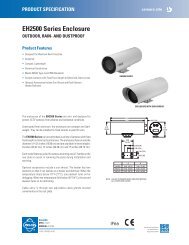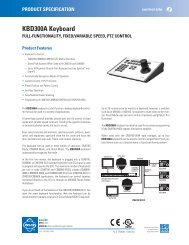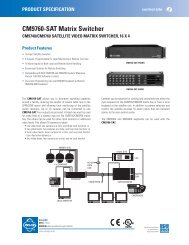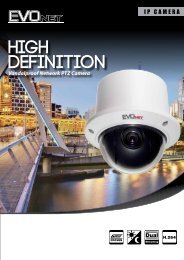Chapter 1 - Pacific Communications
Chapter 1 - Pacific Communications
Chapter 1 - Pacific Communications
You also want an ePaper? Increase the reach of your titles
YUMPU automatically turns print PDFs into web optimized ePapers that Google loves.
Network Video Recorder<br />
<strong>Chapter</strong> 5 — Recording<br />
You can record video from cameras connected to devices registered in the NVR system and SiRiS program<br />
provides three types of recording: Time-Lapse Recording, Event-Based Recording (Event and Pre-Event)<br />
and Instant Recording. During Time-Lapse recording or Event-Based recording, the system performs<br />
recording based on the settings of schedule Presets during the scheduled time. Instant recording can be<br />
manually started or stopped while monitoring video.<br />
When more than one recording mode is set up for the same period, the SiRiS program records video with<br />
the recording settings of the highest priority recording mode. The priority order of recording modes is as<br />
follows: Pre-Event recording (lowest) → Time-Lapse recording or Event recording → Instant recording<br />
(highest). In the same recording mode or between the Time-Lapse recording and Event recording mode,<br />
the schedule higher up the list in the Schedule Setup window has priority over the other schedules. You<br />
can change a schedule’s priority by changing its position in the schedule list.<br />
First, check the following and run the SiRiS Setup program.<br />
• Devices should be added to a device group. Refer to <strong>Chapter</strong> 11 — Device Management (p. 93) for<br />
details.<br />
NOTE: Recording is not supported for DVRs.<br />
5.1 Setting up Recording Schedule<br />
Run the SiRiS Setup program → Select the Recording Schedule menu, and set up the recording<br />
schedule following the procedures below.<br />
NOTES:<br />
• The recording function is supported only for the device registered as the admin user.<br />
• If the same device is registered on another NVR system or a recording service of SiRiS system, only the<br />
first NVR system or recording server that is connected to the device records video. Once a NVR system<br />
or a recording service connects to the device, other NVR systems or recording servers will not record video<br />
from the device unless the connection of the first NVR system or recording service is released.<br />
• The SiRiS program performs recording with the settings of codec, resolution, frame rage and quality set<br />
in the device if the device uses protocols other than SiRiS or ONVIF TM Conformance.<br />
• If the device uses the ONVIF TM Conformance protocol, the SiRiS program performs recording with the<br />
settings of the profile designated in the SiRiS program among preset profiles. You can designate which<br />
profile to use for recording when editing the device settings. Refer to 11.2 Managing Devices, Editing<br />
Device Information (p. 99) and 11.3 Remote Setup of ONVIF TM Conformance Protocol Devices,<br />
Profiles (p. 108) for details.<br />
• When the recording speed and resolution set in the SiRiS program are higher than the Frame Rate and<br />
Max. Resolution set on the device, the recording service will record video at the Frame Rate and Max.<br />
Resolution set on the device (four-channel network video transmitters only which use the SiRiS protocol).<br />
• If network connection is temporarily lost between the device and the NVR system because of network<br />
problems or NVR system reboot, the device saves video temporarily while the network is down (supported<br />
only for devices which use the SiRiS protocol). When network connection is re-established, the device<br />
transmits the saved video to the NVR system at a time. In this case, video recording during the period<br />
might be made with different settings from those in the recording schedule.<br />
• Recording speed might be decreased depending on the network conditions.<br />
57
















